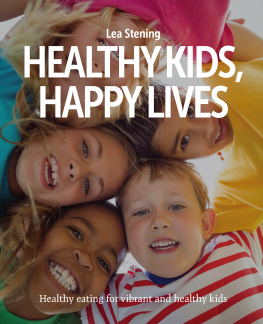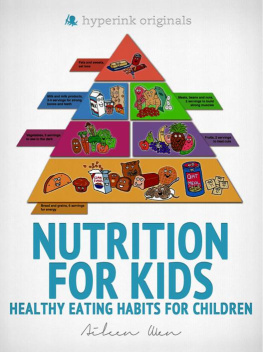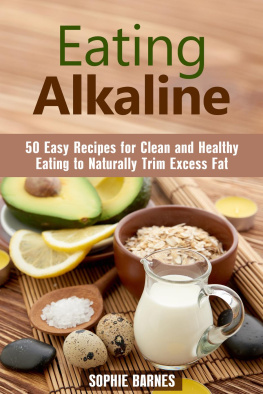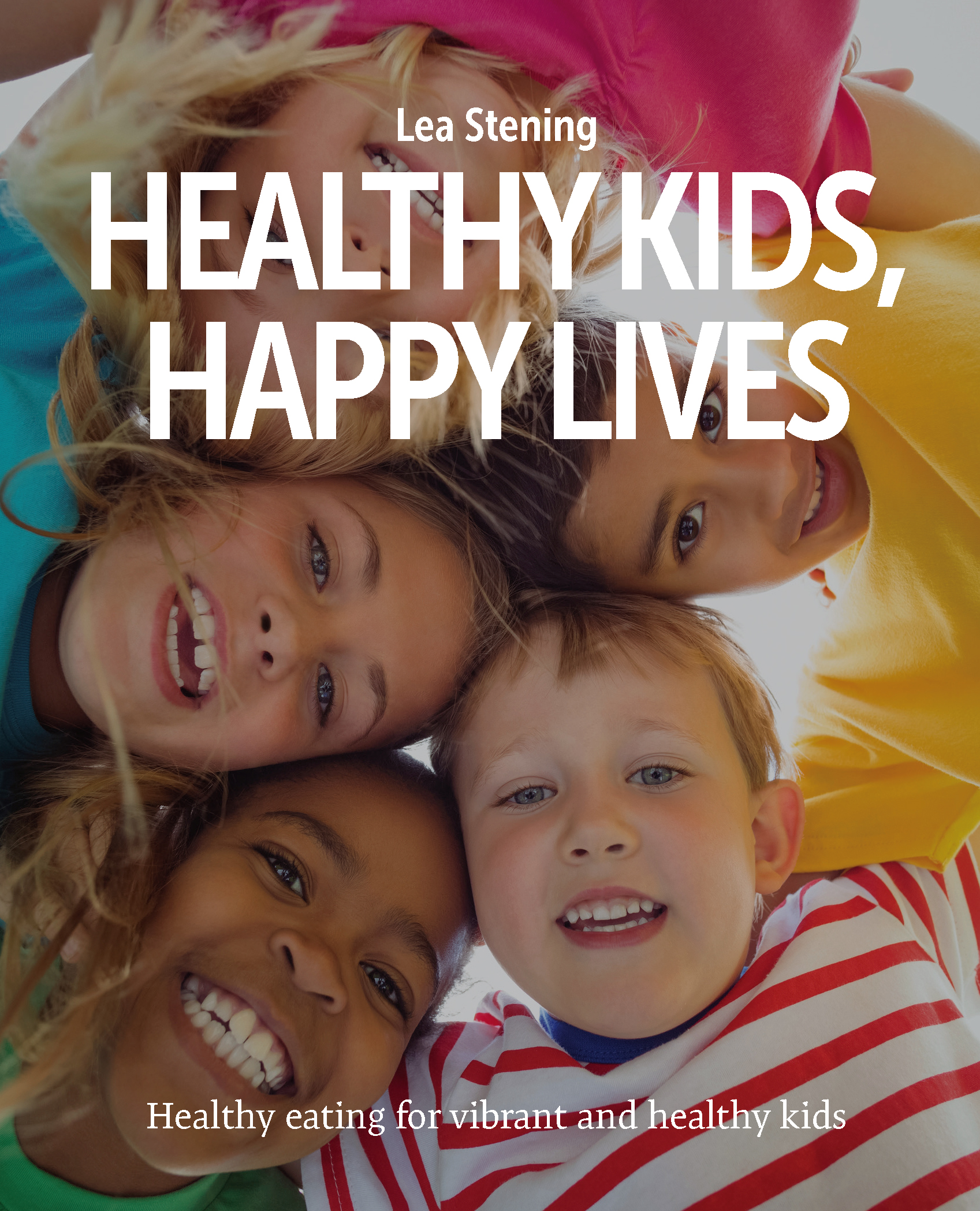Lea Stening
HEALTHY KIDS,
HAPPY LIVES
Disclaimer
This booklet provides a general summary of the subject matter covered; it is not a substitute for informed professional advice. People affected by weight concerns (including family/whanau and others who provide support) should seek professional advice about their individual situation. Lea Stening Health is not liable for any error or omission in this publication, as a result of negligence or otherwise.
Copyright
Copyright 2017 by Lea Stening
All rights reserved. No part of this publication text may be uploaded or posted online without the prior written permission of the publisher.
For permission requests, write to the publisher, addressed Attention: Permissions Request, to .
A catalogue record for this book is available from the National Library of New Zealand.
Table of contents
Introduction
Its a family affair
Obesity is a global problem. In New Zealand, 33% of children and 65% of adults are overweight or obese. The New Zealand population now rates as the third fattest in the OECD after USA and Mexico.
There are also 240,000 people with diabetes living in New Zealand, with a growing contingent of those with Type 2 diabetes. This type used to only affect adults over 40 years of age and, rarely, children under 18 years. Now obesity is causing ten-year-olds to develop diabetes. Somehow we are going astray.
We all want our children to live healthy and happy lives and to reach their full potential. This book is designed as a simple resource to help you and your family, wherever you are, to build sustainable energy by developing a healthy lifestyle and body weight, so you can power through your day with enough energy left over to enjoy each other.
Throughout this book, you will find links to a variety of recent articles, written and posted by Lea on her website, designed to offer you a deeper understanding of nutrition issues, practical tips, and advice.
In recognition that people now travel to places around the world and where food regulations differ, references have also been given to resources available on these subjects in New Zealand, Australia, UK, China and USA.
If you have any concerns regarding your child's health, talk to your doctor and local registered dietitian.
Its fun to watch children growing
The measurement of a childs growth in height and weight can be a good place to start when looking at their overall health. While growth rates are very individual, children usually sustain a steady growth rate between the ages of two to 10 years old.
A final growth spurts begins at puberty, which appears around the ages of 10 to 14 years in girls and 12 to 16 years in boys.
How do you measure a child's growth rate?
There are three main methods useful for monitoring children's growth.
Waist circumference measurements
This is a useful way of tracking changes in children under 12 years.
World Health Organisation Standard Growth Charts
These charts are useful for tracking the proportions of childrens growth. The 50th percentile line is the average progression for age. Height normally exceeds weight, particularly for boys during rapid periods of growth. If your childs height is not progressing, or weight exceeds height into the 85th to 97th percentile or beyond, this is an important topic to discuss with your doctor or paediatric dietitian.
You can download these charts to use at home:
- Weight-for-age (510 years): Girls [PDF] - Boys [PDF]
- Height-for-age (519 years): Girls [PDF] - Boys [PDF]
These charts are also available in imperial mesasurement if you prefer:
- Stature-for-age and Weight-for-age (220 years): Girls [PDF] - Boys [PDF]
Body Mass Index (BMI)
This is a useful tool to relate weight to height for adults (18 years and over). BMI is calculated by dividing weight (body mass) in kilograms or pounds by the square of the body height in metres or inches. If using pounds and inches, multiply the result by 703.

A healthy BMI is 18.524.99, overweight is >25, and obese is > 30.
Either side of this healthy BMI range problems can occur. As BMI drops <18.5 there is a greater risk of bone thinning, fatigue and immune insufficiency and as BMI increases towards 25 the risk of diabetes, heart disease and obesity rises.
The World Health Organisation (WHO) recommends using these same BMI cut-off points for all adults irrespective of their age, sex or ethnicity.
Child Growth Reference Charts
Since the BMI of children rapidly changes as they mature, and growth rates differ between boys and girls, this increases the difficulty of BMI assessment for children.
Instead of using the fixed BMI thresholds (designed for adults), these charts are compared to a reference group of children. This is known as a child growth reference. This shows a pattern of growth and average BMI at a particular age and the percentage of variation.
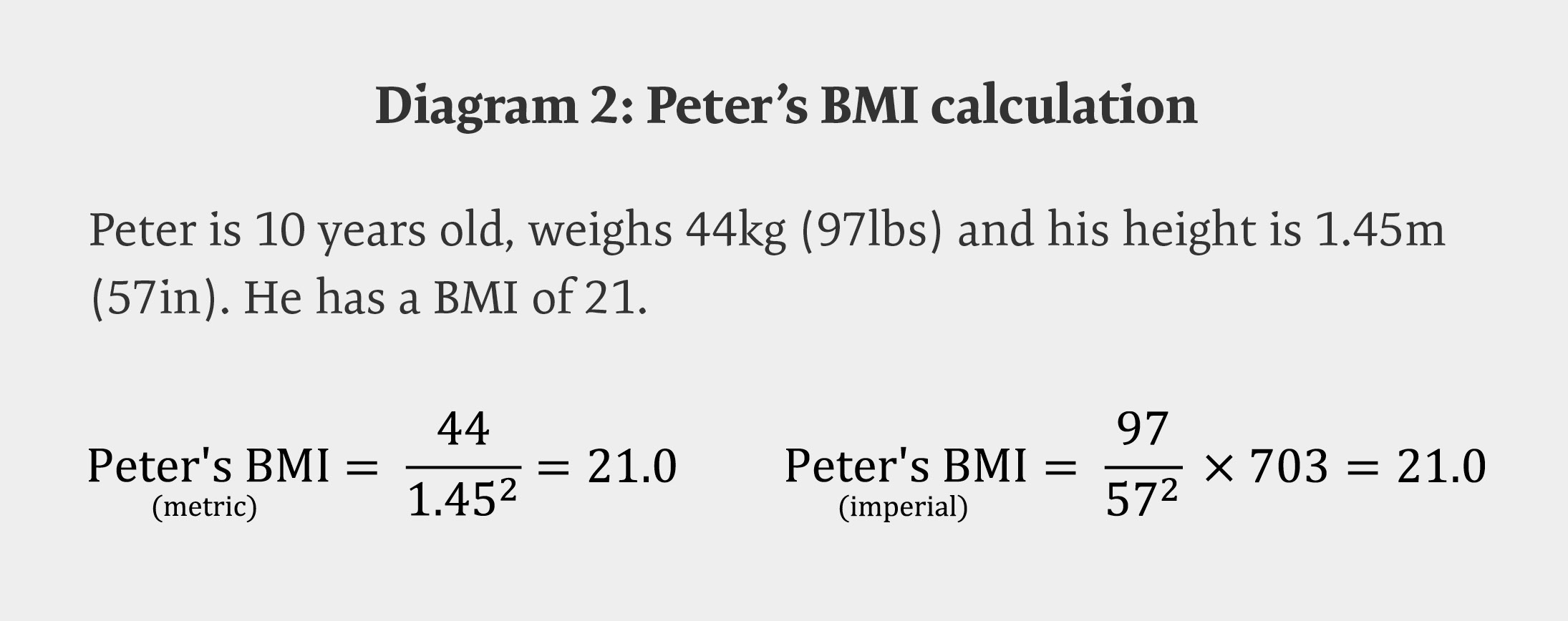
While a BMI of 21 would be healthy for an adult (a healthy BMI range is 18.524.99), the childrens BMI chart below puts Peter on the 97th BMI range for his age. Peters BMI may need monitoring by his doctor or dietitian.
You can download these charts to use at home:
- Body mass index-for-age (519 years): Girls [PDF] - Boys [PDF]
Or in imperial measurement if you prefer:
- Body mass index-for-age (220 years): Girls [PDF] - Boys [PDF]
Eight tips to manage growth
If you have concerns about your childs weight, these few tips might be of help:
1. Avoid negative talk
Studies show that teasing, bullying, and name-calling regarding weight makes matters worse. You cant shame your child slimmer; these sorts of comments will only make a child feel anxious and depressed, and lead to poor self-esteem.
Also avoid making negative comments about your own weight or other peoples efforts at weight loss. Especially avoid encouraging the use of radical fad diets or dietary supplements.
2. Focus on and nurture the talents of your child
When a child can see that any achievement in life (e.g. academic or sporting success, development of computer skills or artistic talents, etc.) takes hard work but is attainable, this builds their self-esteem. These scenarios also raise the possibility that the same amount of effort, when focused on improving health, can also make weight and fitness goals achievable.
3. Focus on healthy eating as a source of energy for reaching goals
If a child loves to play a particular sport, encouraging healthy eating as an important part of their sports nutritional goals is likely to prove more empowering than a negative message.
For instance, saying that healthy eating provides specific energy and nutrients for sport performance might be more encouraging to your child than saying eating junk food results in heart disease or bone loss later in life. If the child is more inclined toward art, music, or academics, the same strategy can also apply.
4. Make home an easy place for health and fitness
This could include buying fresher, healthier food. For instance, parents can bring home more fruit and vegetables as snack items, or start a vegetable garden. As parents, you can also model behaviours for your children to emulate, such as snacking on vegetable sticks with hummus rather than crisps, going for a walk after dinner, and deciding not to keep a television in the bedroom.

